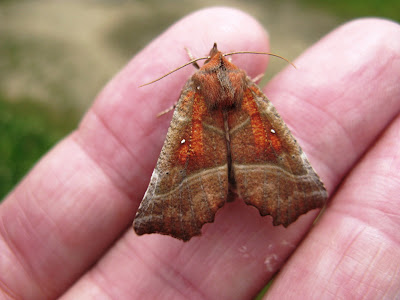





















 What appeared to be Leafy spurge (Euphorbia esula) in Penclacwydd. At the WWT Llanelli, Yellow corydalis (Corydalis lutea), Yellow bartsia (Parentucellia viscosa), Orange hawkweed (Pilosella aurantiaca), Majoram (Origanum vulgare) and Purple loosestrife (Lythrum salicaria) were in bloom. In that location, there was much mating activity by Common blue damselflies (Enallagma cyathigerum) and the Rhagonycha fulva beetle. The Comma butterfly (Polygonia c-album) and the Herald moth (Scoliopterix libatrix) flitted about. Horse flies (Tabanus sudeticus) waited. In Loughor, the Traveller's joy (Clematis vitalba) was imminent. There, the Ringlet butterflies were joined by the Meadow brown (Maniola jurtina) and the Large skipper (Ochlodes venatus). In the same vicinity, Large yellow underwing (Noctua pronuba) and Silver Y (Autographa gamma) moths were also active. An Ichneumon fly (Amblyteles armatorius) lurked. There were lots of ladybird pupae on the Silver birch, giving rise to 2-spot (Adalia bipunctata), 10-spot (Adalia 10-punctata) and Cream-spot (Calvia 14-guttata) adults. There was also a strange orange fly with dark marks on its wings. Visited by a Common footman moth (Eilema lurideola).
What appeared to be Leafy spurge (Euphorbia esula) in Penclacwydd. At the WWT Llanelli, Yellow corydalis (Corydalis lutea), Yellow bartsia (Parentucellia viscosa), Orange hawkweed (Pilosella aurantiaca), Majoram (Origanum vulgare) and Purple loosestrife (Lythrum salicaria) were in bloom. In that location, there was much mating activity by Common blue damselflies (Enallagma cyathigerum) and the Rhagonycha fulva beetle. The Comma butterfly (Polygonia c-album) and the Herald moth (Scoliopterix libatrix) flitted about. Horse flies (Tabanus sudeticus) waited. In Loughor, the Traveller's joy (Clematis vitalba) was imminent. There, the Ringlet butterflies were joined by the Meadow brown (Maniola jurtina) and the Large skipper (Ochlodes venatus). In the same vicinity, Large yellow underwing (Noctua pronuba) and Silver Y (Autographa gamma) moths were also active. An Ichneumon fly (Amblyteles armatorius) lurked. There were lots of ladybird pupae on the Silver birch, giving rise to 2-spot (Adalia bipunctata), 10-spot (Adalia 10-punctata) and Cream-spot (Calvia 14-guttata) adults. There was also a strange orange fly with dark marks on its wings. Visited by a Common footman moth (Eilema lurideola).




3 comments:
Ladybird babies always make me smile. Don't ask me why.
Perhaps because they have avoided all this dangerous 'Your house is on fire, fly away home' business?
Hmmm, yes, there is that association... I think I just like their wriggly fluffiness. They remind me too of monarch butterfly larvae.
Post a Comment